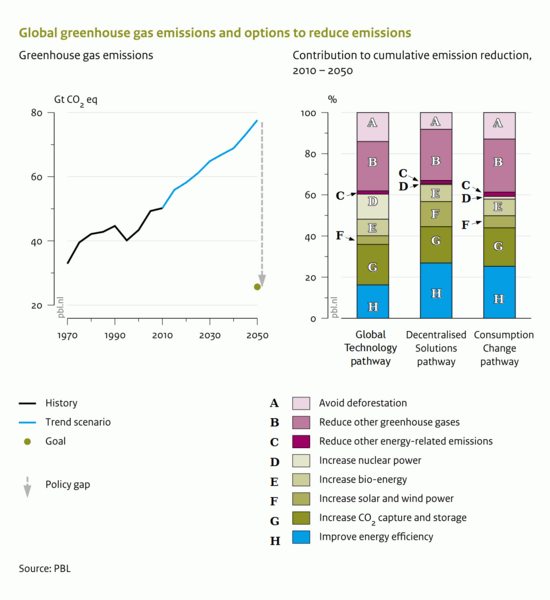Image: Limiting global warming to 2 degrees Celsius - options to reduce greenhouse gas emissions (PBL)

Description: This image shows two graphs. The graphs show how global warming could be limited to below 2 degrees Celsius, relative to the pre-industrial level. Greenhouse gas emissions The graph on the left shows how global greenhouse gas (GHG) emissions (measured in carbon-dioxide equivalents, CO2e) need to be reduced to around 20-25 gigatonnes (Gt) CO2e per year, by 2050 (PBL, 2012, p.156). This is equivalent to a reduction in 2050 of between 40-60%, compared to 1990 emissions levels (PBL, 2012, p.157). The graph shows how emissions are projected to grow in a trend scenario to 60-70 GtCO2e per year, by 2050 (PBL, 2012, p.156). Under the trend scenario, global temperature in 2100 would increase by 2.5-5 °C (PBL, 2012, p.156). In other words, meeting the 2 °C target would require drastic emissions reductions compared to the trend scenario. Contribution to cumulative emission reduction, 2010-2050 The graph on the right shows how the 2 °C target might be achieved. The graph shows three "pathways" to meet the 2 °C target, labelled "global technology", "decentralised solutions", and "consumption change". Each pathway shows how various measures could contribute to emissions reductions. These are: (A) avoid deforestation (B) reduce other (non-CO2) GHGs (C) reduce other energy-related emissions (D) increase nuclear power (E) increase bio-energy (F) increase solar and wind power (G) increase CO2 capture and storage (H) improve energy efficiency For all three pathways, (B), (G) and (H) all make significant contributions to emissions reductions. Below are the approximate contributions of (A)-(H) to the three pathways. Units are the percentage contribution to cumulative emission reduction between 2010-2050. The first number is the "global technology" pathway, the second "decentralised solutions," and the third "consumption change." (A) 14, 8, 13 (B) 24, 25, 26 (C) 3, 2.5, 2.5 (D) 12, 1, 1.5 (E) 8, 7, 8 (F) 4, 12, 6 (G) 20, 17, 18.5 (H) 17, 27, 25
Title: Limiting global warming to 2 degrees Celsius - options to reduce greenhouse gas emissions (PBL)
Credit: Figure 6.14, in: PBL Netherlands Environment Agency (15 June 2012), “Chapter 6: The energy and climate challenge”, in van Vuuren, D. and M. Kok, editors, Roads from Rio+20[1], ISBN 978-90-78645-98-6, p.177, Report no: 500062001. Report website.
Author: PBL Netherlands Environmental Assessment Agency
Permission: Copyright status confirmed by e-mail. See also the PBL website: "Unless stated otherwise, the [Creative Commons — Attribution 3.0 Unported — CC BY 3.0] licence generally applies to the contents of our website. This licence entails the free use (copying, distribution and/or presentation) of any of the PBL publications and derived work, on the precondition of stating the original author – in this case: PBL Netherlands Environmental Assessment Agency. Whenever derived work is used, the user may not give the impression that the PBL Netherlands Environmental Assessment Agency automatically subscribes to the content of such work."
Usage Terms: Creative Commons Attribution 3.0
License: CC BY 3.0
License Link: http://creativecommons.org/licenses/by/3.0
Attribution Required?: Yes
Image usage
There are no pages that link to this image.

